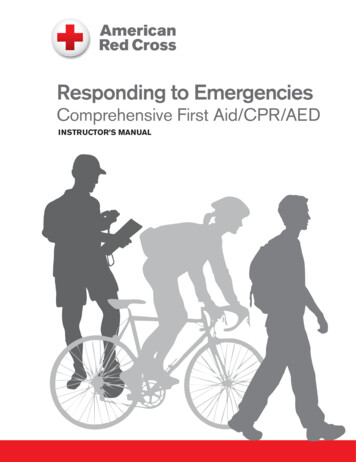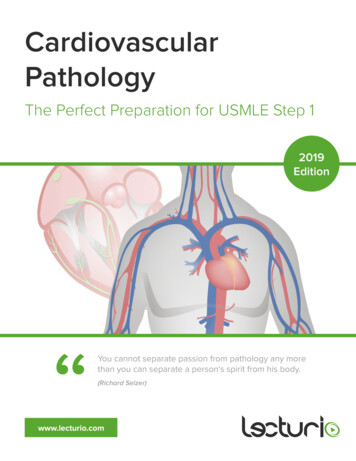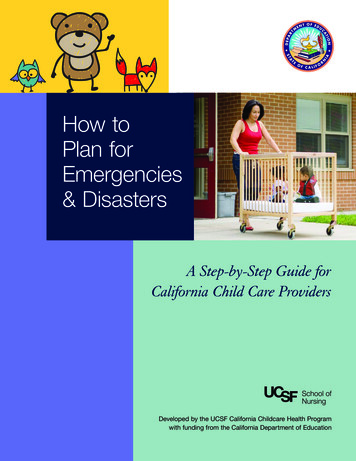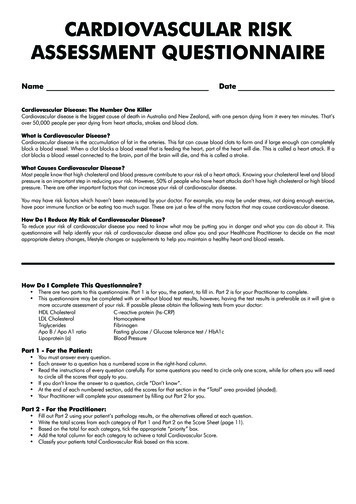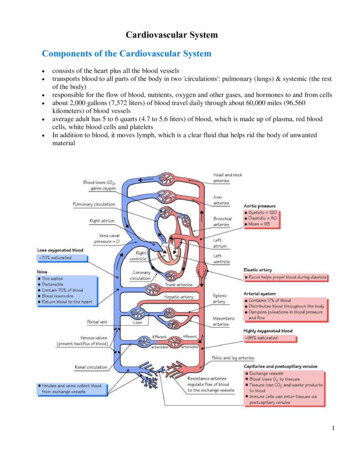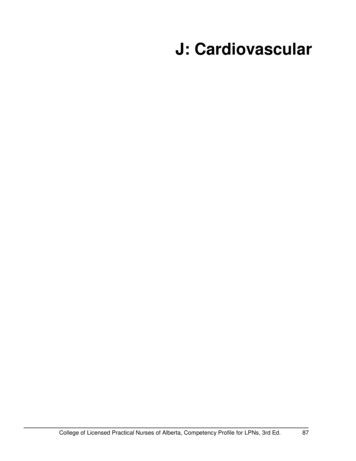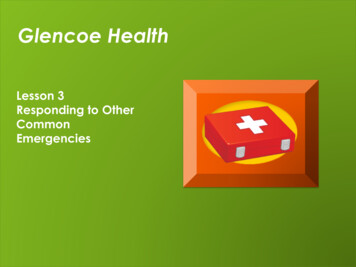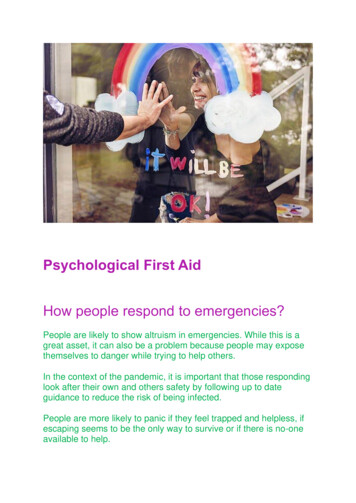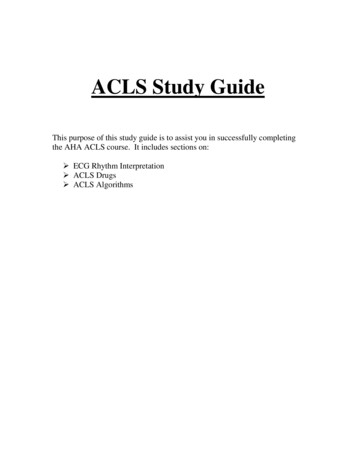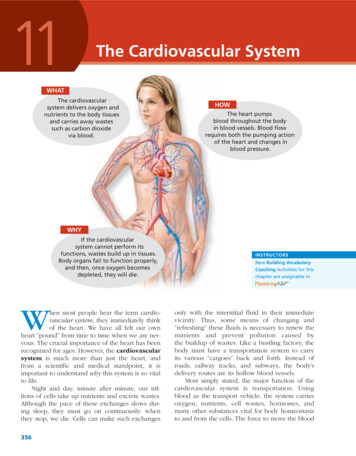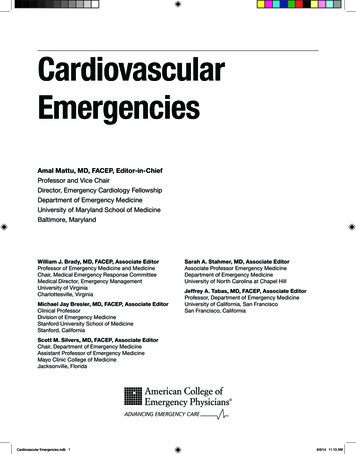
Transcription
CardiovascularEmergenciesAmal Mattu, MD, FACEP, Editor-in-ChiefProfessor and Vice ChairDirector, Emergency Cardiology FellowshipDepartment of Emergency MedicineUniversity of Maryland School of MedicineBaltimore, MarylandWilliam J. Brady, MD, FACEP, Associate EditorProfessor of Emergency Medicine and MedicineChair, Medical Emergency Response CommitteeMedical Director, Emergency ManagementUniversity of VirginiaCharlottesville, VirginiaMichael Jay Bresler, MD, FACEP, Associate EditorClinical ProfessorDivision of Emergency MedicineStanford University School of MedicineStanford, CaliforniaSarah A. Stahmer, MD, Associate EditorAssociate Professor Emergency MedicineDepartment of Emergency MedicineUniversity of North Carolina at Chapel HillJeffrey A. Tabas, MD, FACEP, Associate EditorProfessor, Department of Emergency MedicineUniversity of California, San FranciscoSan Francisco, CaliforniaScott M. Silvers, MD, FACEP, Associate EditorChair, Department of Emergency MedicineAssistant Professor of Emergency MedicineMayo Clinic College of MedicineJacksonville, FloridaCardiovascular Emergencies.indb 18/6/14 11:13 AM
PUBLISHER’S NOTICEThe American College of Emergency Physicians (ACEP) makes every effort to ensure that contributors to its publications are knowledgeablesubject matter experts. Readers are nevertheless advised that the statements and opinions expressed in this publication are provided asthe contributors’ recommendations at the time of publication and should not be construed as official College policy. ACEP recognizes thecomplexity of emergency medicine and makes no representation that this publication serves as an authoritative resource for the prevention,diagnosis, treatment, or intervention for any medical condition, nor should it be the basis for the definition of or standard of care that shouldbe practiced by all health care providers at any particular time or place. Drugs are generally referred to by generic names. In some instances,brand names might be added for easier recognition. Device manufacturer information, if provided, is listed according to style conventionsof the American Medical Association. ACEP received no commercial support for this publication. To the fullest extent permitted by law, andwithout limitation, ACEP expressly disclaims all liability for errors or omissions contained within this publication, and for damages of any kindor nature, arising out of use, reference to, reliance on, or performance of such information. To contact ACEP, write to PO Box 619911, DallasTX 75261-9911; or call toll-free 800-798-1822, or 972-550-0911.Copyright 2015, American College of Emergency Physicians, Dallas, Texas. All rights reserved. Except as permitted under the US CopyrightAct of 1976, no part of this publication may be reproduced, stored, or transmitted in any form or by any means, electronic or mechanical,including storage and retrieval systems, without permission in writing from the publisher. Printed in the USA.Additional copies of this publication can be ordered from the ACEP Bookstore, PO Box 619911, Dallas TX 75261-9911; toll-free 800-798-1822,or 972-550-0911; www.acep.org/bookstore.First printing October 2014ISBN 978-0-9889973-0-1Mary Anne Mitchell, ELS, Managing EditorJessica Hamilton, Educational Products AssistantMike C. Goodwin, Creative Services ManagerNicole Tidwell, Publications Sales and Marketing ManagerMarta Foster, Director, Educational ProductsRobert Heard, MBA, CAE, Associate Executive Director, Membership and Education DivisionIndexing: Hughes Analytics, Chicago, IllinoisPrinting: The Covington Group, Kansas City, MissouriiiCardiovascular Emergencies.indb 28/6/14 11:13 AM
About the EditorsAmal Mattu, MD, FACEP. Since joining the faculty at the University of Maryland School of Medicine in 1996, Dr. Mattuhas had a passion for teaching and writing about emergency cardiology. His commitment to teaching has earned him morethan twenty teaching awards, including national awards from the American College of Emergency Physicians (ACEP) andlocal honors including the Teacher of the Year for the University of Maryland at Baltimore campus and the Maryland StateEmergency Physician of the Year Award. He is a regular speaker at national and international conferences on topics pertainingto emergency cardiology. Dr. Mattu has authored or edited 16 textbooks in emergency medicine, including seven focused onemergency cardiology and electrocardiography. He is also the only emergency physician to serve as primary Guest Editor forCardiology Clinics, which he has done twice. Dr. Mattu is currently a tenured professor, Vice Chair, and director of the Emergency Cardiology Fellowship for the Department of Emergency Medicine at the University of Maryland School of Medicine.William J. Brady, MD, FACEP. Dr. Brady is a tenured professor of emergency medicine and internal medicine at theUniversity of Virginia School of Medicine and is a senator in the Faculty Senate of the University of Virginia. He is the chiefmedical officer and medical director of Allianz Global Assistance (United States and Canada). He lectures locally, regionally,nationally, and internationally on many topics, including the electrocardiogram, cardiac arrest resuscitation, acute coronarysyndrome, and emergency preparedness and response. He is a member of the Academy of Distinguished Educators at theUniversity of Virginia and has received numerous teaching awards, including ACEP’s National Faculty Teaching Award, theUniversity of Virginia School of Medicine Dean’s Award for Excellence in Teaching, and the David A. Harrison DistinguishedEducator Award. He has also published numerous scholarly works, written or edited multiple textbooks, and contributed toclinical policy guidelines for both ACEP and the American Heart Association.Michael Jay Bresler, MD, FACEP. Dr. Bresler is a clinical professor in the Division of Emergency Medicine of theStanford University School of Medicine. Well known as an educator, he is frequently invited to lecture throughout the UnitedStates and internationally. His publications in the medical literature include a number of textbooks, textbook chapters, andpeer reviewed journal articles. Dr. Bresler has been quite active in the legislative process at both the state and federal levels. Hehas written portions of both Federal and California anti-dumping laws, as well as legislation that generates over 200 millionannually in California for the emergency care of indigent patients. Dr. Bresler has won the highest awards for leadership fromboth ACEP and the California chapter of ACEP. He served for a number of years as Speaker of the National Council of ACEP,and before that as President of the California chapter. ACEP has honored Dr. Bresler as a Life Fellow of the College, an Honorary Member, and a Hero of Emergency Medicine.Scott Silvers, MD, FACEP. Dr. Silvers attended medical school at the University of Rochester School of Medicine in Rochester, New York, and received his training in emergency medicine at the Harvard Affiliated Emergency Residency in Boston,Massachusetts. Currently, he is chair of the Department of Emergency Medicine at Mayo Clinic in Jacksonville, Florida, wherehe also serves as co-director of the Mayo Clinic Comprehensive Stroke Center and Chest Pain Center. Dr. Silvers is a memberof both the ACEP Clinical Policies Committee as well as the American Heart Association’s Emergency Cardiovascular CareCommittee where he contributes to the development of national, evidence-based guidelines. He was a co-author of the firstBlueprints in Emergency Medicine study guide, and a co-editor of the Textbook of Emergency Cardiovascular Care and CPR.In coordination with the University of Miami’s Center for Research in Medical Education, Dr. Silvers contributed to the development of the national advanced stroke life support curriculum. He is a reviewer for several journals and a member of theeditorial board of Emergency Medicine Practice.Sarah A. Stahmer, MD. Dr. Stahmer is an associate professor of emergency medicine at the University of North Carolina,Chapel Hill. She has been a program training director in emergency medicine for 15 years, building the academic trainingprograms at Hospital of the University of Pennsylvania, Cooper/RWJ University Hospital, and Duke University Hospital. Heracademic interests are ultrasound in emergency medicine, cardiovascular emergencies, and medical education. She has lecturedextensively on these and other topics regionally, nationally, and internationally. She has received numerous awards for leadership and teaching in medical education that include the 2013 Council of Residency Directors Michael Wainscott Award forleadership and teaching in residency education, the Socrates Teaching Award UNC Emergency Medicine Residency, and theCouncil of Residency Directors Impact Award. Her publications are numerous in the fields of medical education, ultrasound,and cardiac emergencies.Jeffrey A. Tabas, MD, FACEP. Dr. Tabas is a professor of emergency medicine at the University of California San Francisco School of Medicine and practices at San Francisco General Hospital. He received degrees from Brown University and University of Pennsylvania School of Medicine and completed both internal medicine and emergency medicine residencies at University of California Los Angeles Medical Center. Dr. Tabas has worked with ACEP to teach emergency medicine, advancedprocedural skills, and cardiovascular emergencies to a generation of students, residents, and physicians. He has been an activelecturer, author, and editor as well as course chair for ACEP Scientific Assembly and other popular emergency medicine conferences. When not pursuing clinical or academic activities, he is busy spending time with his wife and three children as wellas pursuing his interest in sports, especially throwing hip checks in his ice hockey league for minimally skilled adult players.iiiCardiovascular Emergencies.indb 38/6/14 11:13 AM
DedicationsI would like to thank my wife, Sejal, for her constant support and encouragement; I thank my children, Nikhil, Eleena, and Kamran, for always reminding me of my proper priorities in life; I thank the residents and students at the University of Maryland Schoolof Medicine for providing me the inspiration for the work I do every day; and finally, thanks to my colleagues and mentors, whocontinue to exemplify what I hope one day to become.—Amal MattuI am most fortunate and am appreciative of many people—my parents, William and Joann Brady, for providing the opportunities; my wife, King Brady, for her support, patience, and love; my children, Lauren, Anne, Chip, and Katherine, for their love andinspiration; my chair, Robert O’Connor, MD, for his mentorship and leadership; and my colleagues in emergency medical care, bothhospital- and prehospital-based, for their partnership in healthcare and dedication to the patient.—William J. BradyI would like to dedicate this work to my family, Adrienne, Ben, and Aaron, and to the thousands of emergency physicians whoseefforts day and night provide care and comfort for our fellow human beings.—Michael Jay BreslerThis book is dedicated to my parents for showing me how to live a life of integrity and devotion; to the love of my life, Avery, whois my greatest support and best friend; to my boys, Levi and Austin, who are my best buds and who motivate me to be the best that Ican be; and to all of my many mentors in medicine who have challenged me to understand more about why we do what we do.—Scott SilversFor all those who let me teach the subtleties of ECG interpretation, medication effects on transmembrane potentials, and the evidence behind ACS risk stratification protocols at 2 am and feign to appear interested! I thank you for that gift.—Sarah A. StahmerThis text is dedicated to my wife, children, and parents for their support, love, and faith. I thank my colleagues at Universityof California San Francisco and at the American College of Emergency Physicians for their brilliance, fantastic attitude, and greatfriendship. I also thank the amazing staff at ACEP who made this all possible and finally, the amazing Amal Mattu, who continuesto lead and inspire a generation of physicians.—Jeffrey A. TabasivCardiovascular Emergencies.indb 48/6/14 11:13 AM
ContributorsBenjamin S. Abella, MD, MPhil, FACEPCenter for Resuscitation ScienceDepartment of Emergency MedicineUniversity of PennsylvaniaPhiladelphia, PennsylvaniaChapter 13, Post–Cardiac Arrest SyndromeTyler W. Barrett, MD, MSci, FACEP, FHRSAssociate ProfessorDepartment of Emergency MedicineVanderbilt University Medical CenterNashville, TennesseeChapter 8, BradyarrhythmiasChristopher W. Baugh MD, MBA, FACEPDirector of Observation MedicineDepartment of Emergency MedicineBrigham and Women’s HospitalAssistant Professor of MedicineHarvard Medical SchoolBoston, MassachusettsChapter 20, Use of Emergency Department ObservationUnits for Cardiac PatientsJ. Stephen Bohan, MS, MD, FACP, FACEPExecutive Vice ChairDepartment of Emergency MedicineBrigham and Women’s HospitalAssociate ProfessorHarvard Medical SchoolBoston, MassachusettsChapter 20, Use of Emergency Department ObservationUnits for Cardiac PatientsWilliam J. Brady, MD, FACEP, Associate EditorProfessor of Emergency Medicine and MedicineChair, Medical Emergency Response CommitteeMedical Director, Emergency ManagementUniversity of VirginiaCharlottesville, VirginiaOperational Medical Director, Albemarle County Fire Rescue& Madison County EMSCharlottesville, VirginiaChief Medical Officer & Medical Director, Allianz GlobalAssistanceUnited States & CanadaChapter 2, The Electrocardiogram in the Evaluation andManagement of Acute Coronary SyndromeChapter 9, Narrow Complex Tachycardia: Diagnosis andManagement in the Emergency DepartmentMichael Jay Bresler, MD, FACEP, Associate EditorClinical ProfessorDivision of Emergency MedicineStanford University School of MedicineStanford, CaliforniaChapter 15, Hypertensive Emergencies and Elevated BloodPressureChapter 21, Reducing the Risk of MalpracticeDavid F. M. Brown, MD, FACEPChair and Associate ProfessorDepartment of Emergency MedicineMassachusetts General HospitalHarvard Medical SchoolBoston, MassachusettsChapter 10, Wide Complex TachycardiaTheodore C. Chan, MD, FAAEM, FACEPProfessor and ChairDepartment of Emergency MedicineUniversity of California, San Diego Health SciencesSan Diego, CaliforniaChapter 19, Complications of Implanted Cardiac DevicesEmily K. Damuth, MDAttending PhysicianDivision of Critical Care MedicineDepartment of Emergency MedicineCooper University HospitalCamden, New JerseyChapter 8, BradyarrhythmiasGail Delfin, MSN, RNClinical ResearchCenter for Resuscitation ScienceUniversity of PennsylvaniaPhiladelphia, PennsylvaniaChapter 13, Post–Cardiac Arrest SyndromeDeborah B. Diercks, MD, MSc, FACEPProfessor and Vice Chair of ResearchDepartment of Emergency MedicineUniversity of California, Davis Medical CenterSacramento, CaliforniaChapter 1, Approach to Acute Chest PainLaleh Gharahbaghian, MD, FACEPClinical Assistant ProfessorDirector, Emergency Ultrasound Program and FellowshipDivision of Emergency MedicineStanford University School of MedicineStanford, CaliforniaChapter 4, Bedside Ultrasound for EmergencyCardiovascular DisordersvCardiovascular Emergencies.indb 58/6/14 11:13 AM
John C. Greenwood, MDDepartment of Pulmonary & Critical Care MedicineUniversity of Maryland Medical CenterBaltimore, MarylandChapter 17, Special Populations: Pulmonary Hypertensionand Cardiac TransplantTarlan Hedayati, MD, FACEPAssociate Program DirectorEmergency Medicine Residency ProgramAssistant ProfessorDepartment of Emergency MedicineCook County (Stroger) HospitalRush University Medical CenterChicago, IllinoisChapter 5, Acute Coronary Syndrome: Modern Treatment ofSTEMI and NSTEMIKorin B. Hudson, MD, FACEPAssociate ProfessorDepartment of Emergency MedicineMedStar Georgetown University HospitalWashington, District of ColumbiaChapter 2, The Electrocardiogram in the Evaluation andManagement of Acute Coronary SyndromeKeith A. Marill, MDResearch FacultyDepartment of Emergency MedicineUniversity of PittsburghPittsburgh, PennsylvaniaChapter 10, Wide Complex TachycardiaAmal Mattu, MD, FACEP, Editor-in-ChiefProfessor and Vice ChairDirector, Emergency Cardiology FellowshipDepartment of Emergency MedicineUniversity of Maryland School of MedicineBaltimore, MarylandNorine A. McGrath, MD, FACEPAttending PhysicianDepartment of Emergency MedicineChair, Bioethics CommitteeMedstar Washington Hospital CenterMedstar Georgetown University HospitalWashington, DCChapter 2, The Electrocardiogram in the Evaluation andManagement of Acute Coronary SyndromeAbhi Mehrotra, MD, FACEPAssociate ProfessorChief, Division of Quality and PerformanceDepartment of Emergency MedicineUniversity of North Carolina School of MedicineChapel Hill, North CarolinaChapter 14, Pericarditis, Myocarditis, and EndocarditisChadwick D. Miller, MD, MS, FACEPAssociate ProfessorExecutive Vice Chair and Director of Clinical ResearchDepartment of Emergency MedicineWake Forest University School of MedicineWinston-Salem, North CarolinaChapter 3, Acute Coronary Syndrome: Biomarkers andImagingSiamak Moayedi, MDAssistant ProfessorDepartment of Emergency MedicineUniversity of Maryland School of MedicineBaltimore, MarylandChapter 16, Cardiac Disease in Special Populations: HIV,Pregnancy, and CancerJames V. Quinn, MD, MS, FACEPProfessor of Surgery/Emergency MedicineStanford UniversityStanford, CaliforniaChapter 11, SyncopePeter S. Pang, MD, MSc, FACEP, FAAEM, FACC, FAHAAssociate ProfessorIndiana University School of MedicineIndianapolis, IndianaChapter 7, Acute Heart FailureNathan Parker, MDDepartment of Emergency MedicineUniversity of California, Davis Medical CenterSacramento, CaliforniaChapter 1, Approach to Acute Chest PainPhillips Perera, MD, RDMS, FACEPClinical Associate ProfessorDirector, Emergency Ultrasound ResearchAssociate Director, Emergency Ultrasound DivisionDivision of Emergency MedicineDepartment of SurgeryStanford University Medical CenterStanford, CaliforniaChapter 4, Bedside Ultrasound for EmergencyCardiovascular DisordersJoshua C. Reynolds, MD, MSAssistant ProfessorDepartment of Emergency MedicineCollege of Human MedicineMichigan State UniversityGrand Rapids, MichiganChapter 12, Modern Management of Cardiac ArrestMatthew Salzman, MDAssistant ProfessorMedical ToxicologistDepartment of Emergency MedicineCooper Medical School of Rowan UniversityCamden, New JerseyChapter 18, Pharmacologic Approach to the EmergencyCardiac PatientviCardiovascular Emergencies.indb 68/6/14 11:13 AM
Atman P. Shah, MD, FACC, FSCAICo-Director, Hans Hecht Cardiac Catheterization LaboratoryDirector, Coronary Care UnitAssistant Professor of MedicineThe University of ChicagoChicago, IllinoisChapter 5, Acute Coronary Syndrome: Modern Treatment ofSTEMI and NSTEMIScott M. Silvers, MD, FACEP, Associate EditorChair, Department of Emergency MedicineAssistant Professor of Emergency MedicineMayo Clinic College of MedicineJacksonville, FloridaSarah A. Stahmer, MD, Associate EditorAssociate Professor Emergency MedicineDepartment of Emergency MedicineUniversity of North Carolina at Chapel HillAmita Sudhir, MDAssistant ProfessorDepartment of Emergency MedicineUniversity of VirginiaCharlottesville, VirginiaChapter 9, Narrow Complex Tachycardia: Diagnosis andManagement in the Emergency DepartmentJeffrey A. Tabas, MD, FACEP, Associate EditorProfessor, Department of Emergency MedicineUniversity of California, San FranciscoSan Francisco, CaliforniaSemhar Z. Tewelde, MDInstructorDepartment of Emergency MedicineUniversity of Maryland School of MedicineBaltimore, MarylandChapter 6, Cardiogenic ShockVaishal M. Tolia, MD, MPH, FACEPAssistant Clinical ProfessorAssociate Medical Director, Division of ObservationMedicineDepartment of Emergency MedicineUniversity of California San Diego Health SystemSan Diego, CaliforniaChapter 19, Complications of Implanted Cardiac DevicesNikki B. Waller, MDAssistant Residency Program DirectorDepartment of Emergency MedicineUniversity of North Carolina School of MedicineChapel Hill, North CarolinaChapter 14, Pericarditis, Myocarditis, and EndocarditisNatasha B. Wheaton, MDAssistant Residency Program Director and Clinical AssistantProfessorDepartment of Emergency MedicineUniversity of Iowa Carver College of MedicineIowa City, IowaChapter 7, Acute Heart FailureSarah R. Williams, MD, FACEP, FAAEMClinical Associate ProfessorAssociate Program Director, Stanford/Kaiser EmergencyMedicine ResidencyFounder & Director Emeritus, Stanford EM UltrasoundProgram and FellowshipStanford University School of MedicineStanford, CaliforniaChapter 4, Bedside Ultrasound for EmergencyCardiovascular DisordersMichael E. Winters, MD, FACEP, FAAEMAssociate Professor of Emergency Medicine and MedicineUniversity of Maryland School of MedicineCo-Director, Combined EM/IM/Critical Care ProgramMedical Director, Adult Emergency DepartmentUniversity of Maryland Medical CenterBaltimore, MarylandChapter 17, Special Populations: Pulmonary Hypertensionand Cardiac TransplantMaame Yaa A. B. Yiadom, MD, MPHAssistant ProfessorCooper University HospitalCamden, New JerseyChapter 3, Acute Coronary Syndrome: Biomarkers andImagingMercedes Torres, MDClinical Assistant ProfessorDepartment of Emergency MedicineUniversity of Maryland School of MedicineBaltimore, MarylandChapter 16, Cardiac Disease in Special Populations: HIV,Pregnancy, and CancerviiCardiovascular Emergencies.indb 78/6/14 11:13 AM
viiiCardiovascular Emergencies.indb 88/6/14 11:13 AM
ForewordEmergency physicians serve as front-line clinicians who areexpected to evaluate, stabilize, and begin treatment wheneveran emergency patient presents to the emergency department(ED). As the specialty of emergency medicine has evolved andmatured, so have the expectations for the expertise of the emergency physician. This creates a very exciting but also a verychallenging work environment.Gone are the days when all patients with chest pain getadmitted for observation, every patient who is critically ill iswhisked to an ICU before the initiation of critical care or acardiologist is routinely called to the ED for patients with anunusual or unstable rhythm. Physicians working in an ED arenow expected to have a high level of sophisticated knowledgein all areas of emergency care, with cardiovascular emergenciesbeing one of the most important.Cardiovascular Emergencies by Mattu, Brady, Bresler, Silvers,Stahmer, and Tabas brings together experts in our specialty tocreate an authoritative text for emergency providers. It is a bookby emergency physicians for emergency physicians. It is also anexcellent resource for physicians training in any specialty whowill see cardiovascular emergencies. Each of the editors is a renowned educator and they have carefully selected authors foreach topic. The text’s value is maximized by extremely clearECGs and very high quality graphics and illustrations.The best textbooks are broad enough to include all relevantinformation, but are focused on the core topics readers will needto develop expertise or to serve as a reference. The editors andauthors drew on their many years of experience educating students, residents, and fellow physicians to create a comprehensive textbook of cardiovascular emergencies. They begin with achapter on how to approach chest pain and follow with a chapteron the overt and subtle ECG signs of ischemia and infarction.The evolution of biomarkers as well as the “best” imaging studyto evaluate patients for ischemia follows in separate chapters devoted to each. Up until a few years ago, only cardiologists performed cardiovascular ultrasound. Now emergency physiciansare increasingly using ultrasound to evaluate the heart and greatvessels for evidence of heart failure, tamponade, contractility,RV strain, and volume status; thus, a chapter is devoted to theultrasound findings needed for acute diagnosis and treatmentof cardiovascular emergencies. Finally, there is no emergencythat is more central to emergency care than the treatment of anacute myocardial infarction. This text covers all facets of theacute therapy of both STEMI and NSTEMI.Chapters are also devoted to the management of arrhythmias seen near daily in the ED, including wide and narrowcomplex tachycardias along with bradycardias and heart block.Critical care medicine and cardiology share a number of emergencies, and this text provides up-to-date management of acutedecompensated heart failure, cardiogenic shock, cardiac arrest,and post-cardiac arrest care, covering each with a detailed butsuccinct chapter. Key Point sections throughout all chaptershighlight the most important concepts and clinical insights ofthe authors.Other topics also covered in Cardiovascular Emergencies aresyncope and hypertension, two very common entities, as well asless common but important conditions such as pulmonary hypertension, myocarditis, and pericarditis; complications due toimplanted devices including pacemakers, AICDs, and LVADs;and cardiovascular emergencies in pregnant patients. Cardiacpharmacology, as it applies to emergent patients, and the useof the ED for observation are also presented. Because missing acardiovascular emergency such as a myocardial infarction leadsall other causes in dollars lost to malpractice claims paid, thefinal chapter is devoted to reducing malpractice risks.Cardiovascular Emergencies is a book for anyone who will seea cardiovascular emergency. It is written and edited by expertemergency physicians and is a superb resource. All of us shouldbe indebted to its editors and authors.Corey M. Slovis, MD, FACEP, FACP, FAAEMProfessor of Emergency Medicine and MedicineChairman, Department of Emergency MedicineVanderbilt University Medical CenterMedical Director, Metro Nashville Fire Department andInternational AirportNashville, TennesseeMay 2014ixCardiovascular Emergencies.indb 98/6/14 11:13 AM
xCardiovascular Emergencies.indb 108/6/14 11:13 AM
PrefaceCardiovascular disease accounts for more deaths in the United States and most other first-world countries than any othercause. This number-one ranking has persisted for many yearsdespite marked advances in preventive medicine, diagnostics,and therapeutics. Not only has this rank remained immobile,but the absolute number of deaths due to cardiac disease continues to rise. Most “experts” predict that this is not going tochange in the near future. Therefore, if we in the health carefield have any hope of changing these statistics, we must beoptimally prepared to diagnose and treat patients when theypresent with acute cardiovascular conditions or complications.The specialty of Emergency Medicine bears a great responsibility for the acute care of these patients. We must diagnoseand initiate stabilizing treatment for patients with acute coronary syndromes, acute heart failure, pericarditis, myocarditis,arrhythmias, and many other conditions, and we are frequentlythe key providers who determine the prognosis of patients presenting with cardiac arrest. We are required to carry out theseduties while working under significant time constraints; we areforced to make life-and-death decisions, often with minimalobjective data; and we are often held to impossible standards ofcare by society and the legal profession.The goal of this textbook is to facilitate the efficient andcutting-edge delivery of care to patients who present with acutecardiovascular conditions. To accomplish this goal, we broughttogether many of the brightest minds in Emergency Medicinefrom various institutions to collaborate and create best practicesfor emergency cardiovascular conditions. We believe we haveformulated approaches to the workup and management thatwill optimize patient care.In the pages that follow, we address many of the most common emergency cardiovascular conditions we face in Emergency Medicine as well as some conditions that are rising inimport around the world. Initial chapters focus on the complicated evaluation and differential diagnosis of chest pain andmodern approaches to “low-risk” chest pain. Acute coronarysyndromes are covered in depth, and subsequent chapters address many of the complications associated with coronary arterydisease, including acute heart failure, arrhythmias, and cardiogenic shock. Recent “hot topics” in the Emergency Medicineliterature are addressed, including bedside echocardiography,observation units, cardiac arrest, and post-arrest care. Specialpopulations are also discussed: oncologic patients, pregnantpatients, transplant patients, patients with HIV, patients withpulmonary hypertension, and patients with implanted devices.A special chapter is devoted to issues related to malpractice.In overseeing the development of this text, our goal has beento provide an easily understood, highly visual resource that isreadable from cover to cover. Although this text might be considered a “bookshelf reference,” that designation is at odds withour goal of cover-to-cover readability. We have tried to formatthe chapters for quick reference during everyday patient care.We hope you enjoy reading this book and welcome any andall of your feedback. We would like to thank Linda Kesselring,copyeditor at University of Maryland, and Mary Anne Mitchell, copyeditor at ACEP, whose persistence and insight saw thisproject through to completion and excellence. We would alsolike to thank our families for their patience and understandingwhile we worked on this project, and we thank our colleagues,students, and residents, who have been a constant source of inspiration for our work. We would especially like to thank you,the readers, for your unwavering dedication and commitmentto patient care.Amal MattuWilliam J. BradyMichael J. BreslerScott M. SilversSarah A. StahmerJeffrey A. TabasxiCardiovascular Emergencies.indb 118/6/14 11:13 AM
xiiCardiovascu
ester, New York, and received his training in emergency medicine at the Harvard Affiliated Emergency Residency in Boston, Massachusetts. Currently, he is chair of the Department of Emergency Medicine at Mayo Clinic in Jacksonville, Florida, where he also serves as co-director of the Mayo Clinic Comprehensive Stroke Center and Chest Pain Center. Dr.
